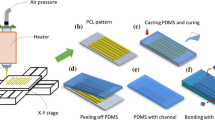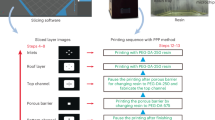Abstract
The print-and-peel (PAP) method enables faster and cheaper fabrication of microfluidic devices, because this non-lithographic method uses a commercial printer to print channel mold patterns onto transparency film for use as a mold for microfluidic device fabrication. This study revisits the solid-ink-based PAP method by characterizing solid link patterns printed on transparency films for cross-sectional shape, height, and surface roughness. In addition, the method was applied to create functional microfluidic devices to show that this low-cost method can be used for microfluidic applications.




Similar content being viewed by others
References
M.S. Thomas, B. Millare, J.M. Clift, D. Bao, C. Hong, V.I. Vullev, Print-and-peel fabrication for microfluidics: What’s in it for biomedical applications? Ann. Biomed. Eng. 38, 21–32 (2010)
A. Tan, K. Rodgers, J.P. Murrihy, C. O’Mathuna, J.D. Glennon, Rapid fabrication of microfluidic devices in poly(dimethylsiloxane) by photocopying. Lab Chip 1, 7–9 (2001)
M.L. Branham, R. Tran-Son-Tay, C. Schoonover, P.S. Davis, S.D. Allen, Rapid prototyping of micropatterned substrates using conventional laser printers. J. Mater. Res. 17, 1559–1562 (2002)
N. Bao, Q. Zhang, J.-J. Xu, H.-Y. Chen, Fabrication of poly(dimethylsiloxane) microfluidic system based on masters directly printed with an office laser printer. J. Chromatogr. A 1089, 270–275 (2005)
V.I. Vullev, J. Wan, V. Heinrich, P. Landsman, P.E. Bower, B. Xia, B. Millare, G. Jones, Nonlithographic fabrication of microfluidic devices. J. Am. Chem. Soc. 128, 16062–16072 (2006)
G.V. Kaigala, S. Ho, R. Peterman, C.J. Bachouse, Rapid prototyping of microfluidic devices with a wax printer. Lab Chip 7, 384–387 (2007)
C. Hong, D. Bao, M.S. Thomas, J.M. Clift, V.I. Vullev, Print-and-peel fabrication of microelectrodes. Langmuir 24, 8439–8442 (2008)
M.S. Thomas, J.M. Clift, B. Millare, V.I. Vullev, Print-and-peel fabricated passive micromixers. Langmuir 26, 2951–2957 (2010)
R.L. Adams, Phase change ink jet technology. In: Rezanka I, Eschbach R (eds) Recent progress in ink jet technologies. The Society for Imaging Science and Technology (1996), pp. 138–141
J. Diener, 2D minimal bounding box version 1.1.0.0, MATLAB Central File Exchange (2011). https://www.mathworks.com/matlabcentral/fileexchange/31126-2d-minimal-bounding-box
T.M. Squires, S.R. Quake, Microfluidics: Fluid physics at the nanoliter scale. Rev. Mod. Phys. 77, 977–1026 (2019)
A. Pekarovicova, H. Bhide, P.D. Fleming III, J. Pekarovic, Phase-change inks. J. Coat. Technol. 75, 65–72 (2003)
R. Li, N. Ashgriz, S. Chandra, J.R. Andrews, Shape and surface texture of molten droplets deposited on cold surfaces. Surf. Coat. Technol. 202, 3960–3966 (2008)
Xerox Phaser Solid-Ink Transparencies, SUPFS-02UC-02. https://www.office.xerox.com/latest/SUPFS-02.PDF
Acknowledgements
This study was supported by an Interdisciplinary Research Grant from the University of Nebraska-Lincoln, USA and by the National Science Foundation Research Experiences for Undergraduates (grant #1659777). Microscopy imaging was performed at the NanoEngineering Research Core Facility (part of the Nebraska Nanoscale Facility), which is partially funded from the Nebraska Research Initiative.
Author information
Authors and Affiliations
Corresponding author
Ethics declarations
Conflict of interest
On behalf of all authors, the corresponding author states that there is no conflict of interest.
Rights and permissions
About this article
Cite this article
Hopper, S., Zhang, H. & Ryu, S. Solid-ink-based print-and-peel method for microfluidic fabrication: a revisit. JMST Adv. 1, 197–203 (2019). https://doi.org/10.1007/s42791-019-00023-2
Received:
Revised:
Accepted:
Published:
Issue Date:
DOI: https://doi.org/10.1007/s42791-019-00023-2




